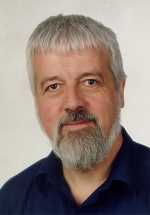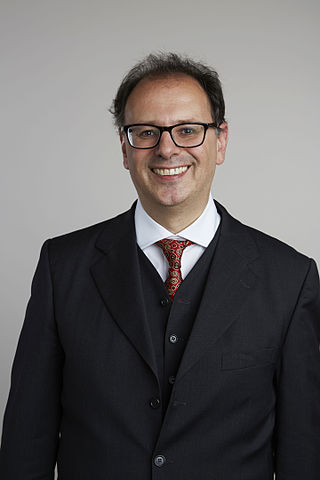Related Research Articles
Petr Čársky is a Slovakian quantum chemist.

The Max Planck Institute for Biophysical Chemistry, also known as the Karl-Friedrich Bonhoeffer Institute, was a research institute of the Max Planck Society, located in Göttingen, Germany. On January 1, 2022, the institute merged with the Max Planck Institute for Experimental Medicine in Göttingen to form the Max Planck Institute for Multidisciplinary Sciences.
The Max Planck Institute for Chemical Energy Conversion is a research institute of the Max Planck Society. It is located in the German town of Mülheim.

The Gottfried Wilhelm Leibniz Prize, or Leibniz Prize, is awarded by the German Research Foundation to "exceptional scientists and academics for their outstanding achievements in the field of research". Since 1986, up to ten prizes have been awarded annually to individuals or research groups working at a research institution in Germany or at a German research institution abroad. It is considered the most important research award in Germany.
The Max Planck Institute for Solid State Research was founded in 1969 and is one of the 82 Max Planck Institutes of the Max Planck Society. It is located on a campus in Stuttgart, together with the Max Planck Institute for Intelligent Systems.

The Max-Planck-Institut für Kohlenforschung is an institute located in Mülheim an der Ruhr, Germany specializing in chemical research on catalysis. It is one of the 86 institutes in the Max Planck Society (Max-Planck-Gesellschaft). It was founded in 1912 in Mülheim an der Ruhr as the Kaiser Wilhelm Institute for Coal Research to study the chemistry and uses of coal, and became an independent Max Planck Institute in 1949.

The Fritz Haber Institute of the Max Planck Society (FHI) is a science research institute located at the heart of the academic district of Dahlem, in Berlin, Germany.

Eric Johnson "Rick" Heller is the Abbott and James Lawrence Professor of Chemistry and Professor of Physics at Harvard University. Heller is known for his work on time-dependent quantum mechanics, and also for producing digital art based on the results of his numerical calculations.

Hermann Hartmann was a German chemist and professor and researcher in physical and theoretical chemistry at the University of Frankfurt am Main. He contributed to all fields of physical chemistry and was instrumental in establishing theoretical chemistry by developing Ligand field theory (1947) and other quantum chemical models including the Hartmann Potential (1971). He also formulated a new perturbation theory (1970–1977) as part of his pioneering research towards a unified field theory of chemical bonding based on a non-linear Schrödinger equation (1980).

Walter Thiel was a German theoretical chemist. He was the president of the World Association of Theoretical and Computational Chemists (WATOC) from 2011.
Edward I. Solomon is the Monroe E. Spaght Professor of Chemistry at Stanford University. He is an elected member of the United States National Academy of Sciences, a Fellow of the American Association for the Advancement of Science, and a Fellow of the American Academy of Arts and Sciences. He has been profiled in the Proceedings of the National Academy of Sciences. He has also been a longtime collaborator with many scientists, including Professor Kenneth D. Karlin at Johns Hopkins University.

ORCA is an ab initio quantum chemistry program package for modern electronic structure methods including density functional theory, many-body perturbation, coupled cluster, multireference methods, and semi-empirical quantum chemistry methods. Its main field of application is larger molecules, transition metal complexes, and their spectroscopic properties. ORCA is developed in the research group of Frank Neese. The free version is available only for academic use at academic institutions.

Ali Alavi FRS is a professor of theoretical chemistry in the Department of Chemistry at the University of Cambridge and a Director of the Max Planck Institute for Solid State Research in Stuttgart.
Karl Wieghardt is a German inorganic chemist and emeritus director of the Max Planck Institute for Chemical Energy Conversion in Mülheim. He was active in the preparation and detailed characterization of models for iron and manganese metalloenzymes, metal complexes of noninnocent ligands, and magnetic interactions in polynuclear metal complexes.
Stefan Grimme, is a German physical chemist; he completed a Ph.D. thesis on photochemistry at Technical University of Braunschweig in 1991; he is a professor at the Universität Bonn since 2011 who is active in the field of computational chemistry; he was elected a member of the Academy of Sciences Leopoldina in 2018.

Wolfgang Lubitz is a German chemist and biophysicist. He is currently a director emeritus at the Max Planck Institute for Chemical Energy Conversion. He is well known for his work on bacterial photosynthetic reaction centres, hydrogenase enzymes, and the oxygen-evolving complex using a variety of biophysical techniques. He has been recognized by a Festschrift for his contributions to electron paramagnetic resonance (EPR) and its applications to chemical and biological systems.
Serena DeBeer is an American chemist. She is currently a W3-Professor and the director at the Max Planck Institute for Chemical Energy Conversion in Muelheim an der Ruhr, Germany, where she heads the Department of Inorganic Spectroscopy. Her expertise lies in the application and development of X-ray based spectroscopic methods as probes of electronic structure in biological and chemical catalysis.
Evgeny E. Nikitin is a Russian theoretical chemist and emeritus professor at the Technion in Haifa, Israel.

The Wilhelm Ostwald Institute for Physical and Theoretical Chemistry at the University of Leipzig, located at Linnéstraße 2 in Leipzig, is the oldest physical chemistry institute in Germany. It is one of seven institutes of the Faculty of Chemistry and Mineralogy of the University of Leipzig. The institute was ceremoniously inaugurated in 1898 by its first director, Nobel Prize winner Wilhelm Ostwald, and has borne the official name "Wilhelm Ostwald Institute for Physical and Theoretical Chemistry" since 1998.

The TUM School of Natural Sciences (NAT) is a school of the Technical University of Munich, established in 2022 by the merger of various former departments. As of 2022, it is structured into the Department of Biosciences, the Department of Chemistry, and the Department of Physics. The school is located at the Garching campus.
References
- ↑ "Molecular Theory and Spectroscopy". www.kofo.mpg.de. Retrieved 16 December 2021.
- ↑ Neese, Frank (2012). "The ORCA program system". WIREs Computational Molecular Science. 2: 73–78. doi:10.1002/wcms.81. S2CID 62137389.
- ↑ Neese, Frank (2009). "Prediction of molecular properties and molecular spectroscopy with density functional theory: From fundamental theory to exchange-coupling". Coordination Chemistry Reviews. 253 (5–6): 526–563. doi:10.1016/j.ccr.2008.05.014.
- ↑ Cox, Nicholas; Pantazis, Dimitrios A.; Neese, Frank; Lubitz, Wolfgang (2013). "Biological Water Oxidation". Accounts of Chemical Research. 46 (7): 1588–1596. doi:10.1021/ar3003249. PMID 23506074.
- ↑ "International Academy of Quantum Molecular Science". www.iaqms.org. Retrieved 16 December 2021.